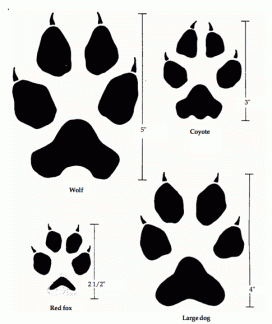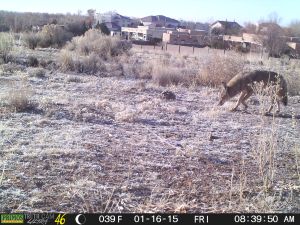Look around! You may not see them but you will know the Coyotes were there if you pay attention to the ground. Are there any paw prints, footprints or tracks? Not a tracker you say, ground is too hard for a visible impression, wouldn’t know a Coyote print from a domestic dog / wolf / fox? The paw print is a good place to start- the following table will help you spot more then just the Coyote’s presence. The accompany table is not drawn to scale but approximate lengths from toe to heel are included in the drawings. Courtesy of Desert USA

Lets start with the table, notice that the Coyote paw print is considerably smaller then the Wolf’s and somewhat smaller then that of the Large Dog’s print. The smallest print is that of the Red Fox though most city dwellers will not see that species especially if Coyotes are present. Having said that it seems a small community named Waverly just outside of Winnipeg Manitoba Canada is now seeing Coyotes where once only the Fox hunted. Adapt or perish? Also in the above table, notice that the two front, inner toes of the Coyote actually turn inward and toward one another. That trait sets the Coyote apart from its cousins almost as much as anything can. In addition to the tracks all animals leave their calling card in the form of droppings. In as much as most domesticated animals are fed prepared foods their droppings do not contain the remains found in Coyote droppings such as bones or remnants of prior meals. Unfortunately, undigested dog and cat collars have been found in Coyote droppings! References suggest Coyote droppings are found on or near the perimeter of their hunting grounds which helps to mark their territory. Look in the center of or along the side of walking paths for twisted / knotted droppings (scat), this is usually a Coyote though other animals do have similar droppings. The droppings and identifiable tracks together will mark the passing of a Coyote in the immediate area. So many cities have removed the larger predators that the Coyote has easily taken over the now pavement lined hunting grounds. Oh, that’s right- a few humans leave their garbage unsecured meaning a buffet of easy pickings. All of us contribute in some form or another to the survivability of Coyotes. Bird feeders and water fountains supply the basic needs for more then just birds. Rabbits and squirrels make their homes close to feeders and available water, this allows the Coyotes a little diversity in their diets. It may be time to re-evaluate the location of those bird feeders and to possibly elevate that fountain higher off the ground and away from vegetation.
Bottom line for Coyote prevention- if your pets and or wild life would eat it so will the Coyote. If the Coyote has acclimated to finding food at specific locations such as the pet’s food bowl in your backyard and it is not available then the next best thing for the Coyote is the family pet. Keep garbage containers securely covered, pet food bowls inside, accompany pets outside, on a short leash when exercising and always, always carry a big stick (tongue in cheek credit to Teddy Roosevelt).
Another episode of the Coyote Cam is at an end but stay tuned, there is more Coyote News on the way.





